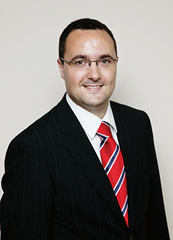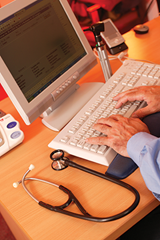Embracing technology to support transformation
 Pat Power, Head of Accenture Ireland’s Healthcare practice, outlines the main trends in health technology and how these can be used in practice to benefit patients.
Pat Power, Head of Accenture Ireland’s Healthcare practice, outlines the main trends in health technology and how these can be used in practice to benefit patients.
Health budgets are under pressure across the EU and the agenda is cost-driven. In Ireland, health spend has been reduced by over €2 billion since 2009 and the HSE has targeted further savings of over €700 million in its 2013 Service Plan. As health organisations face further cost reductions, a key question is “How can healthcare organisations manage cost without compromising patient outcomes?”
Far from compromising healthcare, we have seen that strategically managed cost reduction programmes can be the impetus for radically improved patient outcomes and service delivery. Better patient outcomes and effective cost management are both achievable through carefully selected strategic cost management initiatives although this is not how they are usually portrayed.
The initial phase of a cost reduction programme will be rapid take-out of cost. But a carefully designed and delivered programme will also help re-design healthcare for high performance. This is where the real opportunity to make radical change occurs and with it the potential to dramatically improve patient outcomes.
Technology has a key role to play in enabling this transformation. Designing a sustainable healthcare system depends on making investments in new applications and technologies. In the current economic environment, simultaneously managing cost-cutting and re-investing is one of the toughest challenges that healthcare providers face. However, in today’s digital world, failure to address this challenge is no longer optional.
The leading healthcare providers in the world recognise IT as a strategic asset and are investing in the tools, capabilities and skills that allow them to deliver more targeted patient services that deliver better patient outcomes at a lower cost. The obligation for action is all the more pressing because the technologies to help support the transformation of healthcare are here and now.
Mobile, cloud, social, virtualisation and big data (many of the items continuously listed as ‘hot trends’) are quickly becoming part of the current generation of technology. They are well past the point of exploration and experimentation and are quickly becoming the tools with which healthcare providers can craft fast, cost-effective solutions to support the transformation programme.
The penetration of internet access, mobile technologies and social networks collectively offer a future in which it is possible to transform the delivery of healthcare by offering highly personalised care without necessarily having to do it in person or even with a doctor.
The IT crowd
There are three broad technology trends playing out, each of which will have implications for healthcare’s transformation.
One is size. The sheer scale of digital technology is astonishing. In 2015 alone, the world will produce data equal to 120,000 times the total of all previously written words in history. This data will be generated by exponentially more powerful computing, stored in the cloud and accessible from a growing range of devices. Europeans now have, on average, more than one cell phone per person, while by the end of 2012 over 70 per cent of Irish consumers were expected to own a smartphone.
The second is a shift towards personalisation. All consumer trends point towards greater customisation for an individual’s needs. Websites like Amazon track shopping habits and recommend goods accordingly, while other online services only display content or updates relevant to specific needs.
Third is that technology is more social than ever before. Networks such as facebook, now with over 2.6 million users in Ireland, have helped establish inter-linked communities of users. Consumers increasingly create their own content in addition to accessing what has been created by others. Social networks are not just a place to find friends. They are a becoming a platform for content creation and self-service.
Some government agencies and technology companies have begun deploying social software platforms for citizens to take over certain government functions or customers to provide each other with first level help desk functions. It is not just a way to lower business costs. People feel more engaged and in control when they can do some of the work themselves.
When it comes to healthcare, these developments can and will be applied in a wide variety of ways to support transformation. Take these four examples.
Telehealth, offering patients remote access to healthcare professionals, has major advantages over traditional methods of delivery. It is not just about meeting the needs of the under-served; it is a means of improving care for the already served. While still providing face-to-face care, it gives each patient access to more than one doctor at a time. Digital content added to the encounter can further enhance patients’ understanding of their own health and make the experience more personal.
A great example is TeKi, a solution based on the Microsoft Kinect platform developed by the Basque Health Authority to treat chronic patients in their home. TeKi, which includes a complete set of healthcare measurement devices, allows a healthcare professional to be virtually at the patient’s home every day, providing direct and bi-directional communication with the patient through video-conferencing and daily patient clinical monitoring, as well as advice, guidance and education to help patients manage their conditions and well-being from the comfort of their own homes.
The explosion of smart phones, laptops, tablets and other mobile devices has opened new valves of opportunity in healthcare. Recent Accenture research has shown that mobile solutions can save the US healthcare system more than
$23 billion by targeting patients with chronic diseases, diabetes and heart disease, and an expected $2,000-$3,000 per year in savings per person. Investments in m-health have shown to contribute to 15-20 per cent fewer hospital days, 30 per cent fewer A&E visits and a corresponding improvement in patient outcomes.
Healthcare-specific social networks will help practitioners deliver services but will also enable patients to play a more active role in their care by sharing experiences with others with similar conditions, for example. The power of the crowd will boost resources for all and the benefits of scale will be automatic.
Finally, health analytics. To reach the next level of quality and innovation in care delivery, practitioners require comprehensive facts around healthcare delivery, including compliance with treatment protocols and measurement of system performance and health outcomes. Advanced analytics and new data visualisation techniques will be integrated into the patient pathway as standard to help unlock the power of data to drive more informed decision-making and, ultimately, higher quality, lower cost care from public health monitoring to the treatment of chronic illness and many other health services.
These examples show the tremendous opportunities offered by technology in not only helping to address the apparent conflicting challenge of delivering more healthcare services in a declining budgetary environment, but also supporting and changing the way healthcare is delivered. To achieve and sustain this, IT needs to be recognised as a strategic asset that can and will play an essential role in the transformation journey with IT spend and focus shifting away from ‘keeping the lights on’ towards building the tools, capabilities and skills needed to realise this potential.






